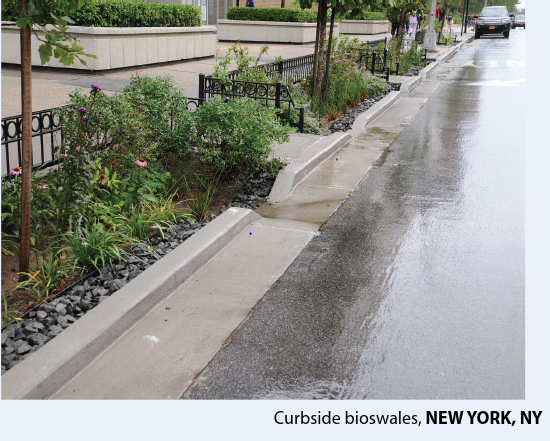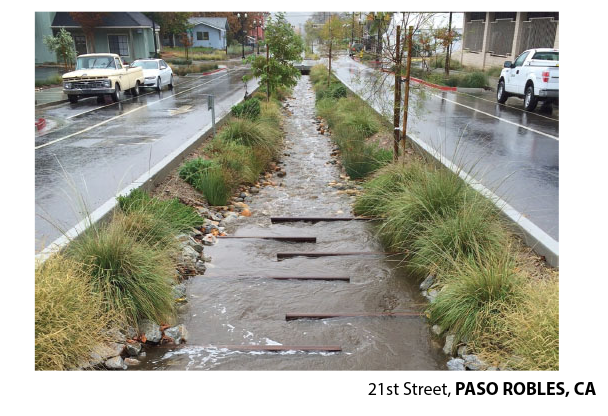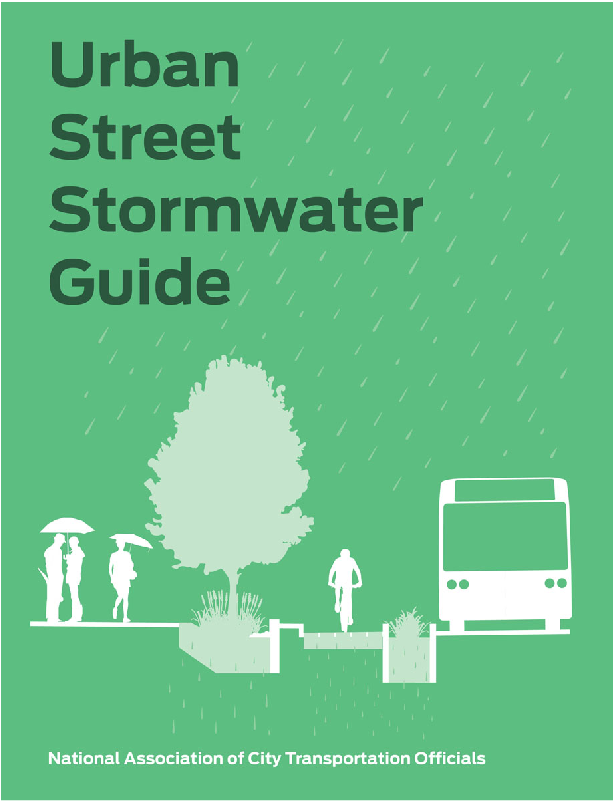One the major prerequisites we need to build the houses we need to combat our housing crisis is infrastructure, without it, the development can’t occur. This post is about a highly but often forgotten element of infrastructure Three Waters – Water Supply, Wastewater & Stormwater focusing in this part again on Stormwater. However, while the previous part focused on traditional Grey Infrastructure this part focuses on Green Infrastructure.
Recently NACTO released the Urban Street Stormwater Guide with a focus on Green Infrastructure. Expanding the view of Green Streets came up in NACTO’s fantastic Global Streets Design Guide which AC has recently endorsed however it was great to read a more specialised guide on the matter. The use of Green Infrastructure is becoming a much more popular part of street design, the reason being that traditional Grey Stormwater systems are very expensive. Green Infrastructure can assist traditional stormwater systems by providing resilience & extra capacity especially in urban areas where impervious surface covers around 60% of land areas, but also by creating more vibrant streets that provide more amenity to residents/visitors as well as providing higher environmental outcomes. Green Streets improve air quality, they mitigate the urban heat island effect, increases species habitat, from small oases for birds and insects to the large water bodies that eventually receive stormwater runoff.

The guide advises to move away from thinking stormwater as waste but instead to design streets to embrace it. So what do NACTO think are the important elements to Green Streets.
- They Protect & Restore Natural Resources.
- They Promote Health, Equity & Human Habitat.
- They are Designed for Safety & Mobility.
- They are Designed for Lifecycle.
- They are Designed to help Provide Resilence.
But Green Streets are not just nice to have, they expand capacity, provide resilience & expand the life of traditional assets lowering long run CAPEX or as NACTO puts it in this case study.
In 2010, New York City estimated that updating the city’s stormwater system to control combined sewer overflows using only gray infrastructure would cost the city $6.8 billion of capital investment over twenty years. By blending gray and green strategies, the city reduced its estimated cost by $1.5 billion.
Green Streets are also integral for a city such as Auckland which is prone to storm events where traditional stormwater infrastructure is overwhelmed causing environmental/health risks as well as frustration. As streets comprise one-third or more of all land and half of the impervious surface in many cities, a huge opportunity exists to use streets better to deal with stormwater. Re-design also has benefits for users with best practice Green Streets you less chance of a car going through a puddle drenching you on the sidewalk, a need to jump over large puddles to not get wet, accessibility to a transit station becomes easier, or for the cyclists who have to cycle through the puddle.

Designing best practice cycle infrastructure can be key for Green Streets & Green Streets key for best practice cycle infrastructure, protected cycle lanes make it easier to implement permeable cycle lanes & Copenhagen lanes (Cycle lanes at a different street level) stop the pooling of stormwater in cycle lanes. Green Street design would also be a great way to implement the Million Trees Programme campaigned on by the Mayor Phil Goff as it would maximise the investment by
- Providing resilience/capacity for the existing Stormwater system providing environmental outcomes as well as saving on traditional grey stormwater infrastructure.
- Combat the Heat Island Effect lowering ambient temperatures in urban areas.
- Acting as a Carbon Sink.
- Creating high amenity neighbourhoods through placemaking.
- Lowering average speeds on streets increasing safety & amenity.
- Higher health outcomes both physical & psychological for residents.
- Reduction in localised pollution from vehicles.
- Improved Business.
- Reduced Crime.
- And more, all which are covered well in this Citylab Article – The Case for More Urban Trees & Dan Burden’s – 22 Benefits of Urban Street Trees.
During the recent AC endorsement of the NACTO Global Streets Design Guide I believe it did include the other guides of which this new guide was pictured. I sincerely hope that ADO/AT include Green Streets thinking as part of the street design guide they are currently working on for Auckland because it’s clear that Green Streets not only have higher social/environmental/health outcomes but also will save the ratepayer money in the long run its a win-win.
This new thinking of how to deal will stormwater will be integral if we are to provide for the growth to tackle this housing crisis, however again it is key that an integrated approach is taken to infrastructure where AC/AT/NZTA/Watercare/Panuku/Crown work together on each area as a complete package of Three Waters, Transport, Planning & Community/Social Services to make work & not in isolation of each other.
I would also recommend the NACTO Guide to those more interested in the area.


 Processing...
Processing...
Excellent post, thanks Harriet. The footprint of a city includes all the resources it imports, and all the pollution it exports. Green streets are part of reducing the pollution part of that footprint.
To incorporate good stormwater management and ecological design including trees, every design coming from Council or AT that makes changes to the built environment, and DOESN’T include these elements needs to be sent back to the drawing board.
Phil Goff also needs to include retaining existing trees as well as having a plan for more trees planted. What’s the point in planting more trees if the mature trees are being cut down?
Pt Chev Town Centre Upgrade – removed about 5 mature trees in the square, and provided a whole lot of concrete. A simple bioswale in the middle of the square, with plants that take up the stormwater readily like reeds and cabbage trees, could have taken all the square’s stormwater.
Pt Chev Rd – where’s the stormwater design? And leave the 12 pohutukawa trees alone. Retailers are concerned about the carparking in the design, but they should be more concerned about the walkability of the area, and cutting down trees is not going to help that.
Mt Albert Town Centre Upgrade – a concerned resident has described the removal of mature plane trees there, after the consultation documents showed leafy scenes. This was supposed to be an upgrade. Plan around the trees, please.
Great article Harriet. Green infrastructure can be fantastic traffic calming too. I’ll try and get some photos for you next time I am up in Long Bay.
The stormwater bollocks has been brought into NZ without any real debate and without any economic analysis. The Council requires rainwater to be collected and ‘treated’ in subdivisions and from roads while at the same time the Council regularly allows sewage to overflow into our harbours. Go figure! For 20 years they insisted on ponds in ever new development on the fringe and now they have decided that ponds don’t work and you have to either have a wetland or mechanical treatment. Then people wonder why houses are unaffordable. Now they want swale streets. Not to fix any problem but so it looks like they care.
Maybe we would do better to all agree we shouldn’t allow shit to enter our rivers and harbours and make that the focus rather than spending other people’s money on stormwater runoff.
This part is not bollocks: a raingarden or bioswale will reduce the peak volume of water getting into the stormwater infrastructure and prevent flooding. Where the wastewater and stormwater are still combined, reducing the peak flow of stormwater into the combined pipe can prevent overflowing of sewage into the harbour.
As to whether the new subdivisions have had silly requirements imposed on them, tell me more. What’s with the “ponds don’t work” change of decision? These new subdivisions will presumably have separated stormwater and wastewater. Road runoff has plenty of pollutants – it’s not ideal that this gets “treated” in soil, but it’s far worse for these pollutants to go straight to sea. The correct place for the stormwater to be directed is into the groundwater and streamwater systems, as that is where it would have gone if the impervious surface hadn’t intercepted the rain.
” What’s with the “ponds don’t work” change of decision?”
Well, ponds don’t work. They heat the water and cause algal blooms which then get released into streams.
@mfwic this has come about due to the RMA surely? We no longer accept heavy metal pollutants running directly into bodies of water. Council are investing heavily to stop sewage overflows in the isthmus, but they really do need to do more.
Your argument seems to be council let shit into the harbor, why can’t I. My argument is that I can’t discharge shit into the sea, why can the council?
My argument is there is only a limited amount of money so we should focus spending where it does the most good. That is on wastewater and preventing stormwater getting into the waste system. The council’s took the view that stormwater ponds in new subdivisions had not cost at all as they made the developer pay. But there was a cost and it was paid by home buyers. Fat lot of good it did too. Meanwhile they allowed practically unlimited development in the CBD but didn’t expect them to pay for fixing the old combined sewers. That was paid by general rates.
There should have been a benefit cost assessment to figure out if any of this stuff was worthwhile. But there wasn’t so a whole lot of filthy ponds got built where more houses could have gone.
+1, there’s a whole lot of stupidly wide streets that could have been actual treatment facilities instead of demanding stormwater ponds everywhere making stormwater worse and taking up valuable land..
Yes I believe the stormwater pond problem is a bit similar to what’s happened to agricultural soils by the NPK tillage regime: we tend to overlook how nature does it, and don’t design with the ecological processes available.
A stormwater retention pond is only a number crunching volume-capacity answer. Those numbers needed to be coupled with a knowledge of how the ecological processes work. We have, and had decades ago, any number of appropriate examples to learn from – many examples are in the permaculture literature, and locally, what they did at Earthsong is a good example.
I hope that the publications Streetguy mentions below are a big step forward. And I don’t think we should be frightened of failure, as long as we learn from it.
Heidi treating stormwater and building those cute little NY style bioswales would be a great thing to do. After we have fixed every other social ill. Poverty, homelessness, healthcare, hip replacements and preventing shit going into the harbour all need to come before building sweet little gardens that do practically nothing. IMHO.
Fallacy of relative privation – I don’t like someone’s proposal but I can’t see anything wrong with it, so instead I point out there are plenty of worse problems in the world. Often supported by putting a dollar value on taking action to emphasise the scarcity of options.
No just inefficient allocation. We got all that stormwater stuff from the ARC. The people who sat on that Council were so remote from people that they truly thought they could improve the environment at no cost. But it does have a cost, just like their Metropolitan Urban Limits had a cost. The price was homelessness for some and a much lower standard of housing for everyone else. The real shame is it has such little impact on our environment that it was practically worthless.
We’re well past “do it with no thought for the cost.” WSD now is “spend a little to do stormwater right whenever you’re doing a job.” And it starts with cutting down on unnecessary asphalt for residential “car deserts” – streets with vast space for parking anywhere, that never get used for anything much.
Done right, it can save the cost of pipes and manholes, so it pays its own way in capital costs, and repays in ecological benfits and well-being.
“WSD now is ‘spend a little to do stormwater right whenever you’re doing a job.’ ”
Probably true if it was a job involving stormwater in the first place. How do we get this to extend to other projects, like a town centre upgrade or a cyclelane? I believe those designers are just instructed to avoid anything to do with changing the stormwater so we miss out on some of the possible options and economies of changing everything at once.
I mean, I have picked up and carried elderly people across the puddle that forms on the pedestrian crossing on Pt Chevalier Rd. Yet the town centre upgrade did not install a raingarden, and neither does the proposed cyclelane along there.
Yes, could do better. Sometimes. it’s the people who promote the project, who need to see that including SW management and tree planting are more than just nice to have. Iwi consultation often keeps a focus on good environmental outcomes.
Sometimes it’s just the wrong time – other stuff needs to happen before road run-off can be fixed economically, like combined sewer separation.
And sometimes it’s NZTA funding rules that mean you can’t do all the sensible things at one time to top up a project’s funding.
Here’s some economic analysis that council did: http://www.aucklandcouncil.govt.nz/SiteCollectionDocuments/aboutcouncil/planspoliciespublications/technicalpublications/tr2013043aucklandunitaryplanstormwatermanagementprovisionscostbenefitassessmentappendix.pdf
If you look through some of the other council research in 2013, you’ll see this stormwater bollocks was given a decent amount of consideration before it got written into the Unitary Plan: http://www.aucklandcouncil.govt.nz/EN/planspoliciesprojects/reports/technicalpublications/Pages/technicalreports2013.aspx. Plenty of other research on the council website from other years that’s related to this topic too: http://www.aucklandcouncil.govt.nz/EN/planspoliciesprojects/reports/technicalpublications/Pages/home.aspx
This is how japan done it. They make a river park which also act as storm water path.
https://youtu.be/FvJIAgLj1Po
That link doesn’t seem to be the right one. I am interested in a Japanese example, though.
https://youtu.be/-tm8WRniGFY
Thanks, Harriet, for a really good post. Auckland has published GD04: Guidance for Water Sensitive Design in the Auckland Design Manual. The Unitary Plan process has delayed the production of detailed design guidance for Auckland, as calculations need to match the AUP performance Rules, but this is close to ready.
NACTO Urban Street Stormwater Guide is a good coverage, most appropriate to dealing with existing streets. Auckland also needs good detailed guidance on putting GD04 into practice in greenfield and large brownfield developments for network and street design. This will be written as an integral part of Street Design guidance.
A lot has already been done with new developments, especially those SHAs designed under the PAUP while hearings progressed.
The new raingardens on some Christchurch streets certainly got a good workout last weekend – see https://www.facebook.com/rebuildchristchurch/videos/1801913509833717/
A good resource for this kind of stuff is the Australian CRC for Water Sensitive Cities website (https://watersensitivecities.org.au/). The Aussies are streets ahead of us (and everyone else) in water-sensitive urban design (WSUD) with long-running, well-funded research programmes which demonstrate clear benefits of WSUD applications for environmental protection, flood attenuation, biodiversity enhancement, amenity improvement and potable water conservation.
Just as there is growing awareness globally that cities are not just things for driving over, so there is increasing recognition that urban waterways are not just drains for disposing of stormwater, but are functional ecological systems worthy of protection. A key objective of WSUD is to protect and enhance receiving waterways by moderating the “flashiness” of urban runoff and removing heavy metals and other road-derived eco-toxicants.
A recently completed example in Auckland is the stormwater treatment wetland at Brylee Reserve which has transformed a boggy grassed area of virtually no ecological merit into a facility which treats residential and SH1 runoff prior to discharge to Manakau Harbour. While the wetland vegetation is not yet fully established, photos on the website of the company that provided the plants give a sense of the outcome (http://www.kauriparknurseries.co.nz/projects/brylee-reserve-wetland/).
Love these green street designs.
Hello. Could you please tell me where the image at the very top of the article is from? And would it be possible to get a high res copy of it? I would like to include it in an educational presentation about biophilic streets. Many thanks!